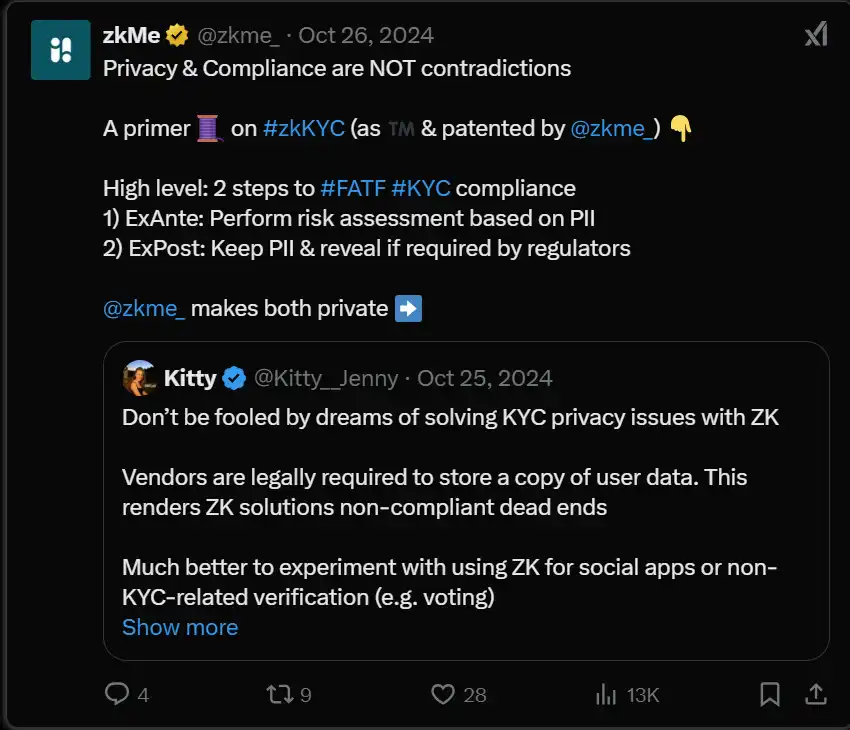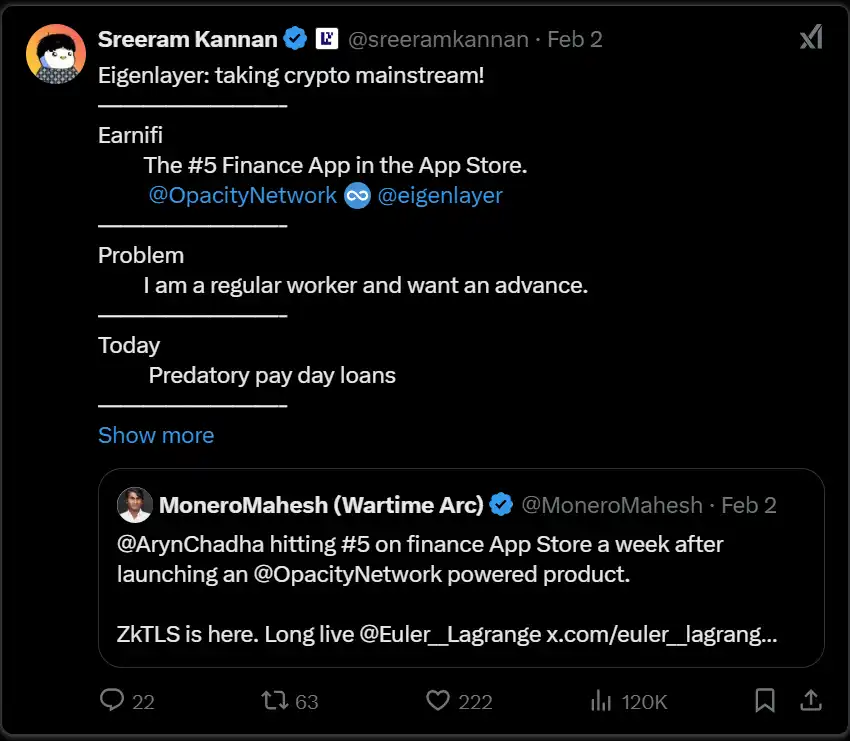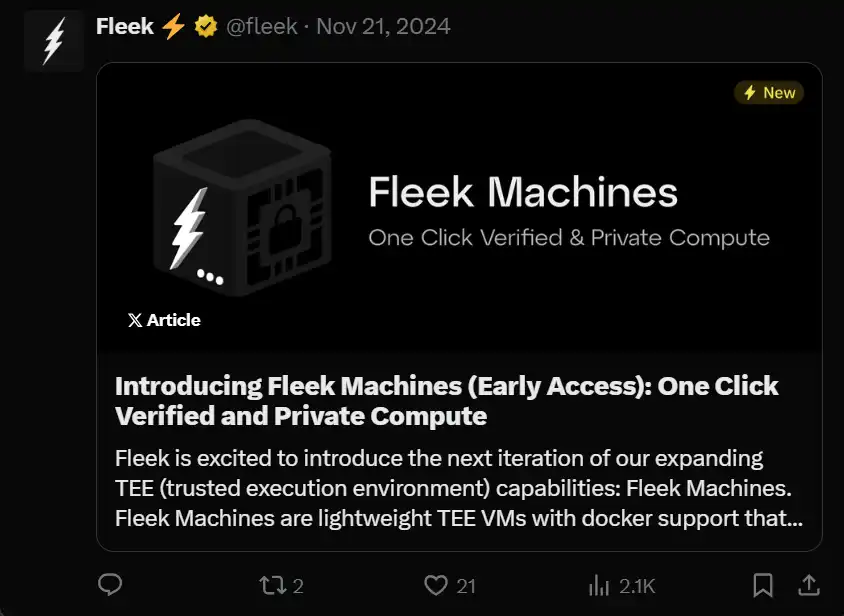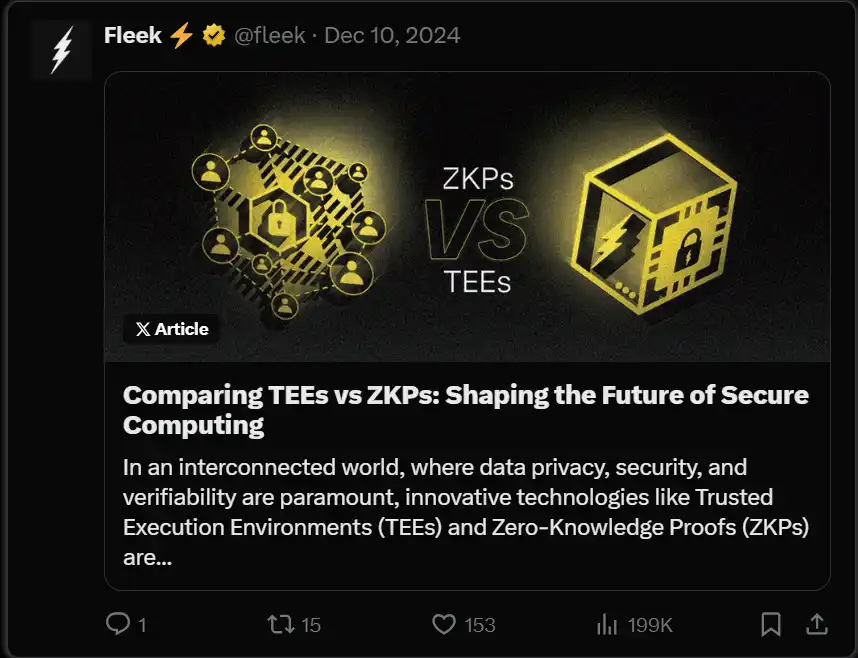With the surge in AI development, while enhancing privacy protection, it has further complicated the realms of privacy and verifiability.
Author: Defi0xJeff, Head of Steak Studio
Translated by: zhouzhou, BlockBeats
Editor’s Note: This article focuses on various technologies that enhance privacy and security, including Zero-Knowledge Proofs (ZKP), Trusted Execution Environments (TEE), and Fully Homomorphic Encryption (FHE), introducing their applications in AI and data processing, how they protect user privacy, prevent data leaks, and improve system security. The article also mentions several case studies, such as Earnifi, Opacity, and MindV, demonstrating how these technologies enable risk-free voting, data encryption processing, etc., while also facing many challenges, such as computational overhead and latency issues.
The following is the original content (reorganized for readability):
With the surge in data supply and demand, the digital footprints left by individuals have become increasingly extensive, making personal information more susceptible to misuse or unauthorized access. We have already seen some cases of personal data breaches, such as the Cambridge Analytica scandal.
Those who have not caught up can refer to the first part of the series, where we discussed:
- The importance of data
- The growth of AI's demand for data
- The emergence of data layers

Regulations such as the GDPR in Europe, the CCPA in California, and others around the world have made data privacy not just an ethical issue but a legal requirement, pushing companies to ensure data protection.
With the surge in AI development, AI has complicated the field of privacy and verifiability while enhancing privacy protection. For example, while AI can help detect fraudulent activities, it has also enabled "deepfake" technology, making it more challenging to verify the authenticity of digital content.
Advantages
- Privacy-preserving machine learning: Federated learning allows AI models to be trained directly on devices without centralizing sensitive data, thus protecting user privacy.
- AI can be used to anonymize or pseudonymize data, making it difficult to trace back to individuals while still being usable for analysis.
- AI is crucial for developing tools to detect and reduce the spread of deepfakes, ensuring the verifiability of digital content (as well as detecting/verifying the authenticity of AI agents).
- AI can automatically ensure that data processing practices comply with legal standards, making the verification process more scalable.
Challenges
- AI systems often require large datasets to operate effectively, but the ways data is used, stored, and accessed may be opaque, raising privacy concerns.
- With sufficient data and advanced AI technology, individuals may be re-identified from datasets that should have been anonymous, undermining privacy protection.
- As AI can generate highly realistic text, images, or videos, distinguishing between real and AI-generated content becomes more difficult, challenging verifiability.
- AI models can be deceived or manipulated (adversarial attacks), undermining the verifiability of data or the integrity of the AI system itself (as shown in cases like Freysa, Jailbreak, etc.).
These challenges have driven the rapid development of AI, blockchain, verifiability, and privacy technologies, leveraging the strengths of each technology. We have seen the rise of the following technologies:
- Zero-Knowledge Proofs (ZKP)
- Zero-Knowledge Transport Layer Security (zkTLS)
- Trusted Execution Environments (TEE)
- Fully Homomorphic Encryption (FHE)
1. Zero-Knowledge Proofs (ZKP)
ZKP allows one party to prove to another that they know certain information or that a statement is true without revealing any information beyond the proof itself. AI can leverage this to demonstrate that data processing or decisions meet certain standards without disclosing the data itself. A good case study is getgrass.io, which utilizes idle internet bandwidth to collect and organize public web data for training AI models.

Grass Network allows users to contribute their idle internet bandwidth through a browser extension or application, which is used to scrape public web data and then process it into structured datasets suitable for AI training. The network executes this web scraping process through nodes run by users.
Grass Network emphasizes user privacy by only scraping public data, not personal information. It uses zero-knowledge proofs to verify and protect the integrity and provenance of the data, preventing data corruption and ensuring transparency. All transactions from data collection to processing are managed through sovereign data aggregation on the Solana blockchain.
Another good case study is zkme.
zkMe's zkKYC solution addresses the challenge of conducting KYC (Know Your Customer) processes in a privacy-preserving manner. By leveraging zero-knowledge proofs, zkKYC enables platforms to verify user identities without exposing sensitive personal information, thus protecting user privacy while maintaining compliance.

2. zkTLS
TLS = a standard security protocol that provides privacy and data integrity between two communicating applications (often associated with the "s" in HTTPS). zk + TLS = enhanced privacy and security in data transmission.
A good case study is OpacityNetwork.
Opacity uses zkTLS to provide secure and private data storage solutions. By integrating zkTLS, Opacity ensures that data transfers between users and storage servers remain confidential and tamper-proof, addressing inherent privacy issues in traditional cloud storage services.

Use Case—Earnifi for Early Wage Access: Earnifi is reportedly climbing to the top of app store rankings, especially among financial applications, leveraging OpacityNetwork's zkTLS.
- Privacy: Users can provide their income or employment status to lenders or other services without disclosing sensitive banking information or personal details, such as bank statements.
- Security: The use of zkTLS ensures that these transactions are secure, verified, and kept private. It avoids the need for users to entrust all their financial data to third parties.
- Efficiency: The system reduces the costs and complexities associated with traditional early wage access platforms, which may require cumbersome verification processes or data sharing.
3. TEE
Trusted Execution Environments (TEE) provide hardware-enforced isolation between normal execution environments and secure execution environments. This may be the most well-known security implementation in AI agents today, ensuring they are fully autonomous agents. Promoted by 123skely's aipool tee experiment: a TEE presale event where the community sends funds to agents, which autonomously issue tokens based on predetermined rules.

Marvin Tong's PhalaNetwork: MEV protection, integrating ai16zdao's ElizaOS, and Agent Kira as verifiable autonomous AI agents.

Fleek's one-click TEE deployment: focused on simplifying usage and improving developer accessibility.

4. FHE (Fully Homomorphic Encryption)
A form of encryption that allows computations to be performed directly on encrypted data without needing to decrypt it first.
A good case study is mindnetwork.xyz and its proprietary FHE technology/use cases.

Use Case—FHE Heavy Staking Layer and Risk-Free Voting
FHE Heavy Staking Layer
By using FHE, the staked assets remain encrypted, meaning private keys are never exposed, significantly reducing security risks. This ensures privacy while also verifying transactions.
Risk-Free Voting (MindV)
Governance voting is conducted on encrypted data, ensuring that votes remain private and secure, reducing the risk of coercion or bribery. Users gain voting power (vFHE) by holding staked assets, decoupling governance from direct asset exposure.
FHE + TEE
By combining TEE and FHE, they create a powerful security layer for AI processing:
- TEE protects operations in the computing environment from external threats.
- FHE ensures that operations are always performed on encrypted data throughout the process.
For institutions handling transactions from $100 million to over $1 billion, privacy and security are crucial to prevent front-running, hacking, or exposure of trading strategies.
For AI agents, this dual encryption enhances privacy and security, making it highly useful in the following areas:
- Sensitive training data privacy
- Protection of internal model weights (preventing reverse engineering/IP theft)
- User data protection
The main challenge of FHE remains the high overhead due to computational intensity, leading to increased energy consumption and latency. Current research is exploring methods such as hardware acceleration, hybrid encryption techniques, and algorithm optimization to reduce computational burdens and improve efficiency. Therefore, FHE is best suited for low-computation, high-latency applications.
Summary
- FHE = operations on encrypted data without decryption (strongest privacy protection but most expensive)
- TEE = hardware, secure execution in isolated environments (balancing security and performance)
- ZKP = proving statements or authenticating identities without revealing underlying data (suitable for proving facts/credentials)
This is a broad topic, so this is not the end. A key question remains: in an increasingly sophisticated era of deepfakes, how can we ensure that AI-driven verifiability mechanisms are truly trustworthy? In the third part, we will delve into:
- Verifiability layers
- The role of AI in verifying data integrity
- Future developments in privacy and security

免责声明:本文章仅代表作者个人观点,不代表本平台的立场和观点。本文章仅供信息分享,不构成对任何人的任何投资建议。用户与作者之间的任何争议,与本平台无关。如网页中刊载的文章或图片涉及侵权,请提供相关的权利证明和身份证明发送邮件到support@aicoin.com,本平台相关工作人员将会进行核查。




